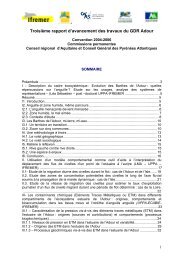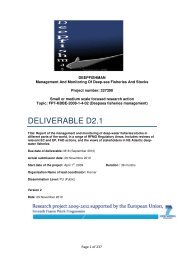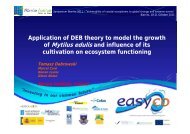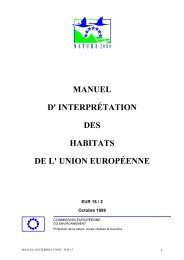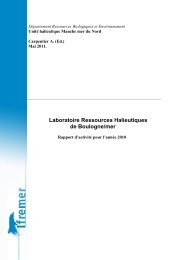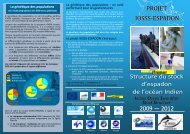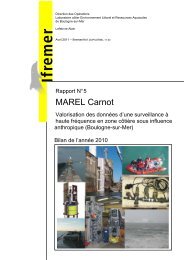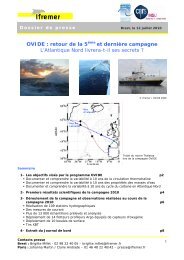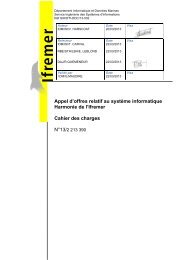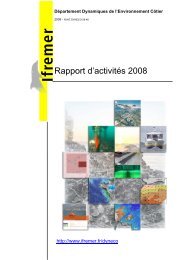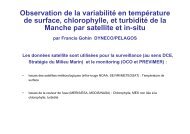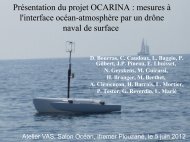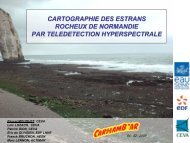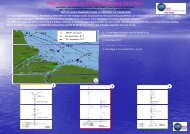Project Deliverable D50 Report on Best Practices Workshop - Ifremer
Project Deliverable D50 Report on Best Practices Workshop - Ifremer
Project Deliverable D50 Report on Best Practices Workshop - Ifremer
You also want an ePaper? Increase the reach of your titles
YUMPU automatically turns print PDFs into web optimized ePapers that Google loves.
Hydrothermal ecosystems from video imagery and temperature time-series<br />
Authors: J. Sarrazin, P-M. Sarradin, O. Gauthier (IFREMER) and M. Grégoire (Telecom<br />
Bretagne)<br />
Abstract: Located <strong>on</strong> oceanic ridges, hydrothermal ecosystems are characterized by str<strong>on</strong>g<br />
physico-chemical gradients and the presence of a unique fauna, sustained by microbial<br />
chemosynthesis. Several studies have shown that the spatial distributi<strong>on</strong> and compositi<strong>on</strong> of<br />
vent faunal assemblages were str<strong>on</strong>gly correlated to geological, physical and chemical<br />
processes at different spatial and temporal scales but almost no data are available <strong>on</strong> the<br />
temporal dynamics of these ecosystems. The major objective of this research project is to<br />
develop a video processing platform to analyze the temporal dynamics of hydrothermal<br />
ecosystems. This data al<strong>on</strong>g with abiotic data measured within the envir<strong>on</strong>ment (temperature,<br />
ir<strong>on</strong> and oxygen c<strong>on</strong>centrati<strong>on</strong>s) will be analyzed and compared using multivariate statistics<br />
including PCNM and cluster analyses. Finally, all the data will be fed within a GIS that will<br />
allow for a graphical representati<strong>on</strong> of all the observed temporal variati<strong>on</strong>s. More specifically,<br />
we are looking to answer the following questi<strong>on</strong>s: (i) What biological and geological data can<br />
be automatically extracted from video imagery to feed the temporal data base, (ii) what are<br />
the different scales of variati<strong>on</strong>s of envir<strong>on</strong>mental c<strong>on</strong>diti<strong>on</strong>s (e.g. temperature) and (iii) what<br />
are the links between envir<strong>on</strong>mental changes and faunal dynamics in hydrothermal<br />
ecosystems ?<br />
Methane bubbles analysis in the framework of MARMARA dem<strong>on</strong>strati<strong>on</strong> missi<strong>on</strong><br />
Author: I. Lebl<strong>on</strong>d (IFREMER)<br />
Slides in Annex F5<br />
Abstract: Observati<strong>on</strong>s of fluid plumes in the water column, bubbles of methane for<br />
example, show an increasing interest since several years. The study of the l<strong>on</strong>g-term<br />
variability of the emitted quantities could be linked to varied works: we can cite preventi<strong>on</strong> of<br />
natural risks (earthquakes, tsunamis, etc), impact of the methane discharge to climate change,<br />
etc. So, a bubbles detector dem<strong>on</strong>strator, with acoustic sensor, has been deployed in 2009 in<br />
the Marmara sea. The principle of the engine is as follow: the module, named BOB (Bubbles<br />
OBservatory Module) is put <strong>on</strong> the seafloor. It’s an aut<strong>on</strong>omous module, and we can expect a<br />
c<strong>on</strong>tinuous recording during about <strong>on</strong>e m<strong>on</strong>th. At the top of the instrument, we find the<br />
acoustic sensor (a 120 kHz split-beam echo-sounder, as used in fisheries acoustics), placed <strong>on</strong><br />
a pan & tilt system. With this system, the positi<strong>on</strong> of the sounder (geographical sectors for<br />
example) can be easily changed. The principle of acquisiti<strong>on</strong> data is as follow: an acoustic<br />
signal is emitted by the echo-sounder, in an horiz<strong>on</strong>tally positi<strong>on</strong> according to previously<br />
chosen sectors, and the backscattering signal is recorded.<br />
Post-processing is realised a posteriori, after the recovery of the module. It c<strong>on</strong>sists at first to<br />
compute the volume backscattering vs time (echo-integrati<strong>on</strong> principle, used in fisheries<br />
acoustics).<br />
A particular attenti<strong>on</strong> is made to guaranty quantitative measures and a certain interoperability:<br />
o Data are recorded in an internati<strong>on</strong>al format “Hac” (Descripti<strong>on</strong> of the ICES HAC<br />
standard data exchange format – ICES Cooperative Research <str<strong>on</strong>g>Report</str<strong>on</strong>g>. 278,<br />
December 2005).<br />
o Data are calibrated, which allow quantitative measures and comparis<strong>on</strong>s with other<br />
acoustic sensors.<br />
o Data are georeferenced, which allow comparis<strong>on</strong>s with several sensors (acoustic or<br />
others) or with other surveys.<br />
<str<strong>on</strong>g>Deliverable</str<strong>on</strong>g> #50 - update October 2010 24



